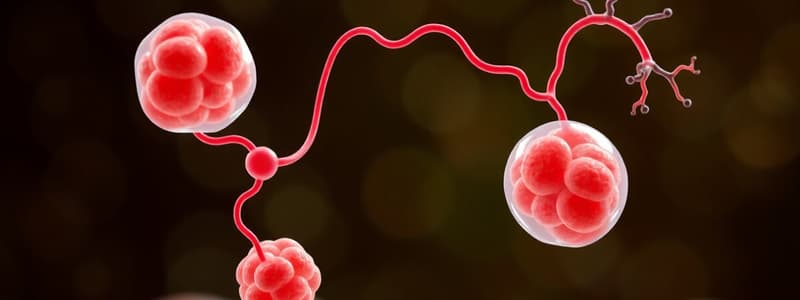Podcast
Questions and Answers
What is the main product of glycolysis?
What is the main product of glycolysis?
- Glucose
- ATP
- Pyruvate (correct)
- NADH
Glycolysis occurs in the mitochondria.
Glycolysis occurs in the mitochondria.
False (B)
During glycolysis, how many ATP molecules are consumed?
During glycolysis, how many ATP molecules are consumed?
2
The process that occurs if there is no oxygen present after glycolysis is called ______.
The process that occurs if there is no oxygen present after glycolysis is called ______.
What is produced at the end of pyruvate oxidation?
What is produced at the end of pyruvate oxidation?
The Krebs Cycle requires oxygen to produce CO2.
The Krebs Cycle requires oxygen to produce CO2.
What molecule do the acetyl groups bind to during pyruvate oxidation?
What molecule do the acetyl groups bind to during pyruvate oxidation?
The end result of glycolysis includes 2 NADH and ______ Pyruvate.
The end result of glycolysis includes 2 NADH and ______ Pyruvate.
Match the following stages of cellular respiration with their main output:
Match the following stages of cellular respiration with their main output:
How many times must the Krebs Cycle occur for one glucose molecule?
How many times must the Krebs Cycle occur for one glucose molecule?
Flashcards are hidden until you start studying
Study Notes
Glycolysis (Cytoplasm)
- Breakdown of glucose (6-carbon sugar) into 2 molecules of pyruvate.
- 2 ATP consumed to convert glucose into fructose.
- Fructose splits into G3P, which is oxidized; electrons transferred to NAD+ forming 2 NADH.
- Final conversion of G3P to pyruvate produces a net gain of 2 ATP.
- NET result: 2 ATP, 2 NADH, and 2 pyruvate molecules.
- In absence of oxygen, pyruvate undergoes fermentation; in presence of oxygen, it shifts to the mitochondria.
Pyruvate Oxidation (Matrix)
- Pyruvate moves from cytoplasm to mitochondrial matrix.
- Each pyruvate loses one carbon, resulting in 2-carbon acetyl group.
- Reduction of NAD+ to NADH occurs during carbon loss.
- Acetyl group binds to coenzyme A, forming acetyl-CoA.
- End results: 2 CO2, 2 NADH, and 2 acetyl-CoA produced.
The Krebs Cycle (Inner Membrane)
- Requires oxygen and results in CO2 production.
- Acetyl-CoA combines with a 4-carbon molecule to form a 6-carbon compound.
- 6-carbon compound loses a carbon as CO2, generating NADH from NAD+.
- Five-carbon molecule then releases another CO2, producing additional NADH and ATP.
- Four-carbon molecule undergoes transformations to release electrons, forming 1 FADH2 and another NADH.
- Cycle restarts when four-carbon molecule binds to new acetyl-CoA; cycle must occur twice per glucose to process 2 pyruvate.
Studying That Suits You
Use AI to generate personalized quizzes and flashcards to suit your learning preferences.




